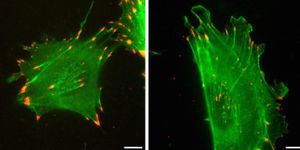Fossil Reveals New Take on How Dinosaurs Breathed
There are a variety of ways that animals breathe. When the diaphragm muscle moves in humans, our lungs expand and take in air, and we exhale and compress the lungs, it goes in the opposite direction. The lungs in birds, however, don't move that way; they have air sacs that sit outside of the lungs and pump air in. It's been thought that dinosaurs probably breathed in the same way as birds because the anatomy in that part of their bodies is similar. However, new work has shown that in a type of dinosaur called Heterodontosaurus, which has bones like toothpicks and paddle-shaped ribs, that's not the case. New research reported in eLife has suggested that Heterodontosaurus expanded its chest and belly to breathe.
"We actually have never known how these [Ornithischians] breathed," said lead study author Viktor Radermacher, a graduate student at the University of Minnesota.
This research utilized a well-preserved Heterodontosaurus fossil. The dinosaur is the oldest of the Ornithischian line, which includes duck-billed dinosaurs, stegosaurus, and triceratops. The three major dinosaur groups are sauropods, theropods, and ornithischians.
The Heterodontosaurus specimen was analyzed with high-powered X-rays that were produced by a synchrotron, which spins electrons at the speed of light. The X-ray data enabled the researcher to make a digital reconstruction of the dinosaur skeleton so they could assess its characteristics.
The work revealed postcranial features that have not been observed in any other ornithischian before this, according to the study authors. They suggested that the findings, like a large sternum that projected in the anterior direction, unusual ribs and a structure called a gastral basket, suggest that the dinosaur's body could expand as it breathed in cycles.
"The interesting thing is that Heterodontosaurus is the ancestor of this group and it has these [newly discovered] pieces of anatomy, but its descendants don't. What that means is that Heterodontosaurus is a missing link between the ancestors of dinosaurs and the bigger, charismatic species we know. This gives us a whole bunch of information and fills in some pretty glaring gaps in our knowledge of the biology of these dinosaurs," noted Radermacher.
"The takeaway message is that there are many ways to breathe," Radermacher said. "And the really interesting thing about life on Earth is that we all have different strategies to do the same thing, and we've just identified a new strategy of breathing. This shows that utilizing dinosaurs and paleontology, we can learn more about the diversity of animals on Earth and how they breathe."
Sources: AAAS/Eurekalert! via University of Minnesota, eLife









